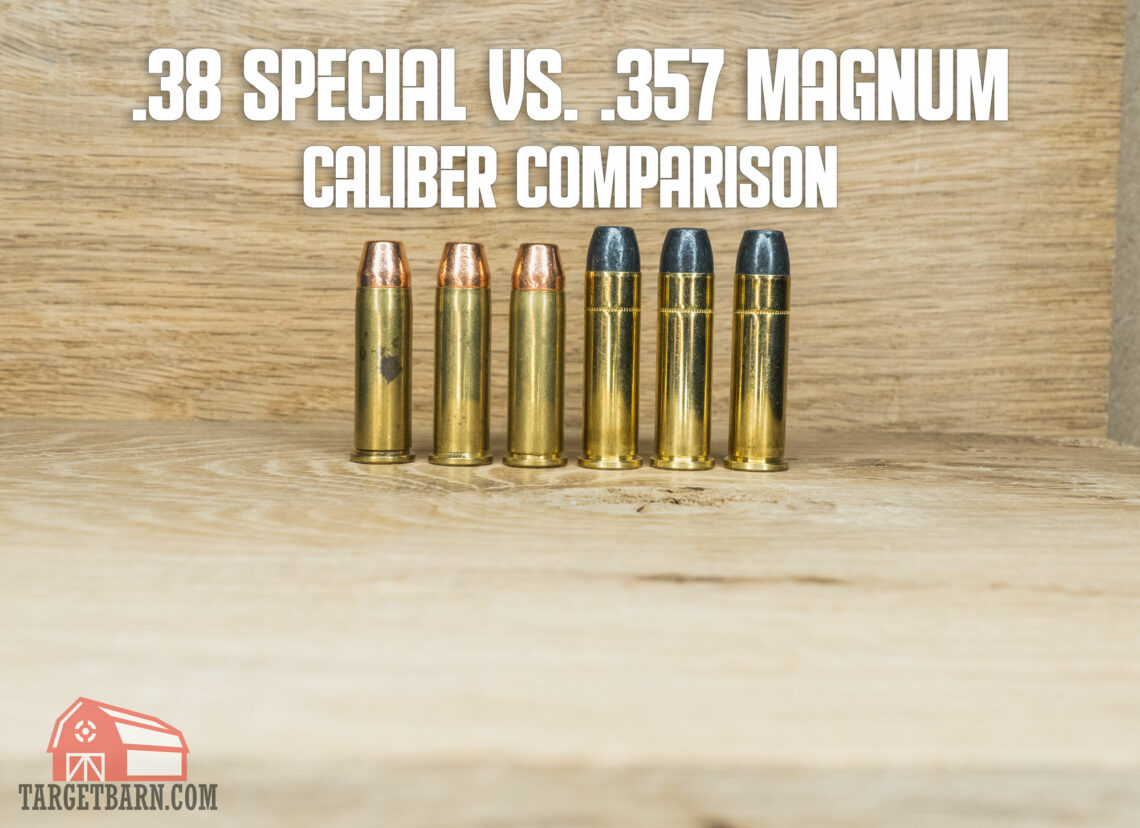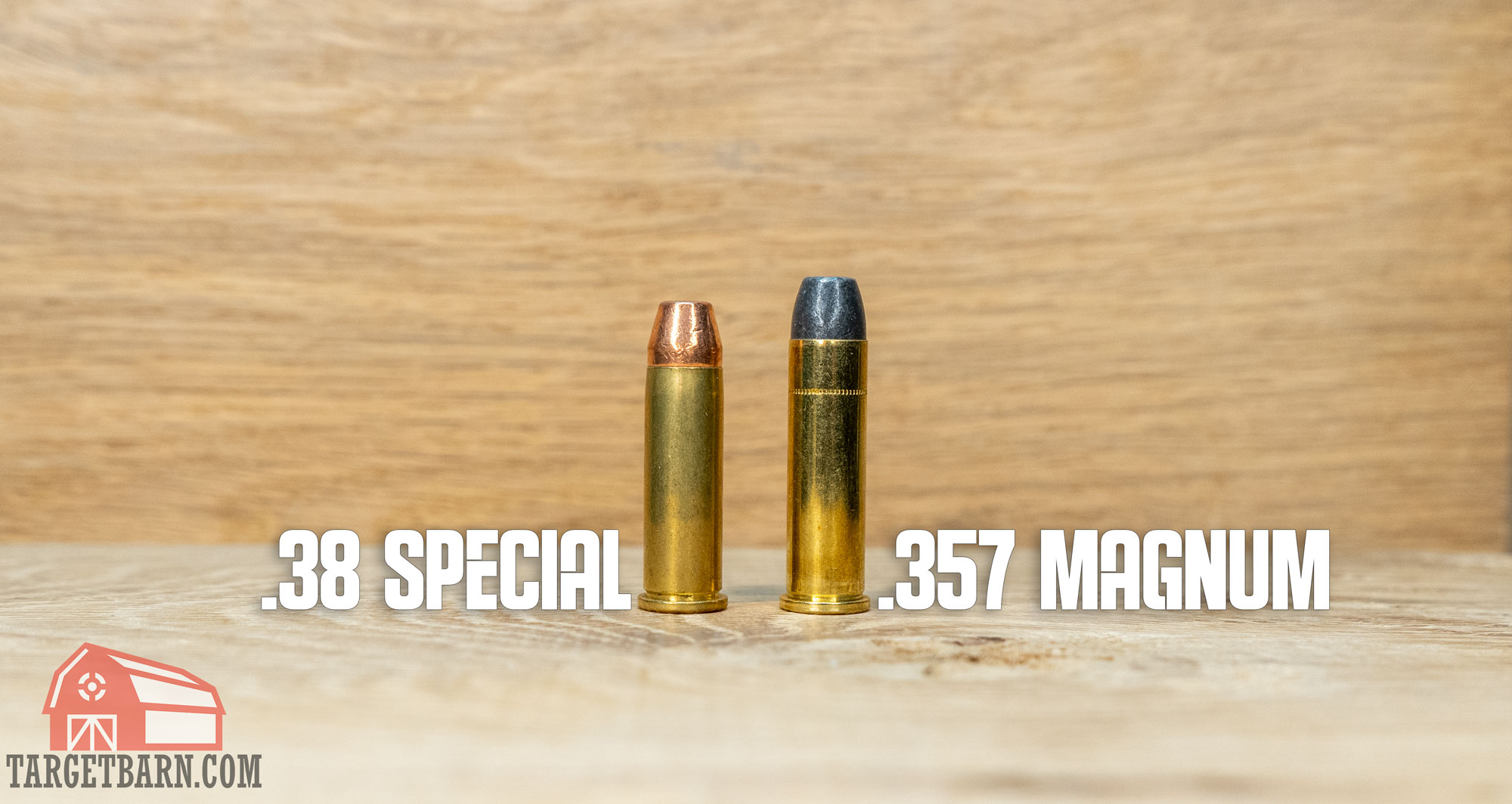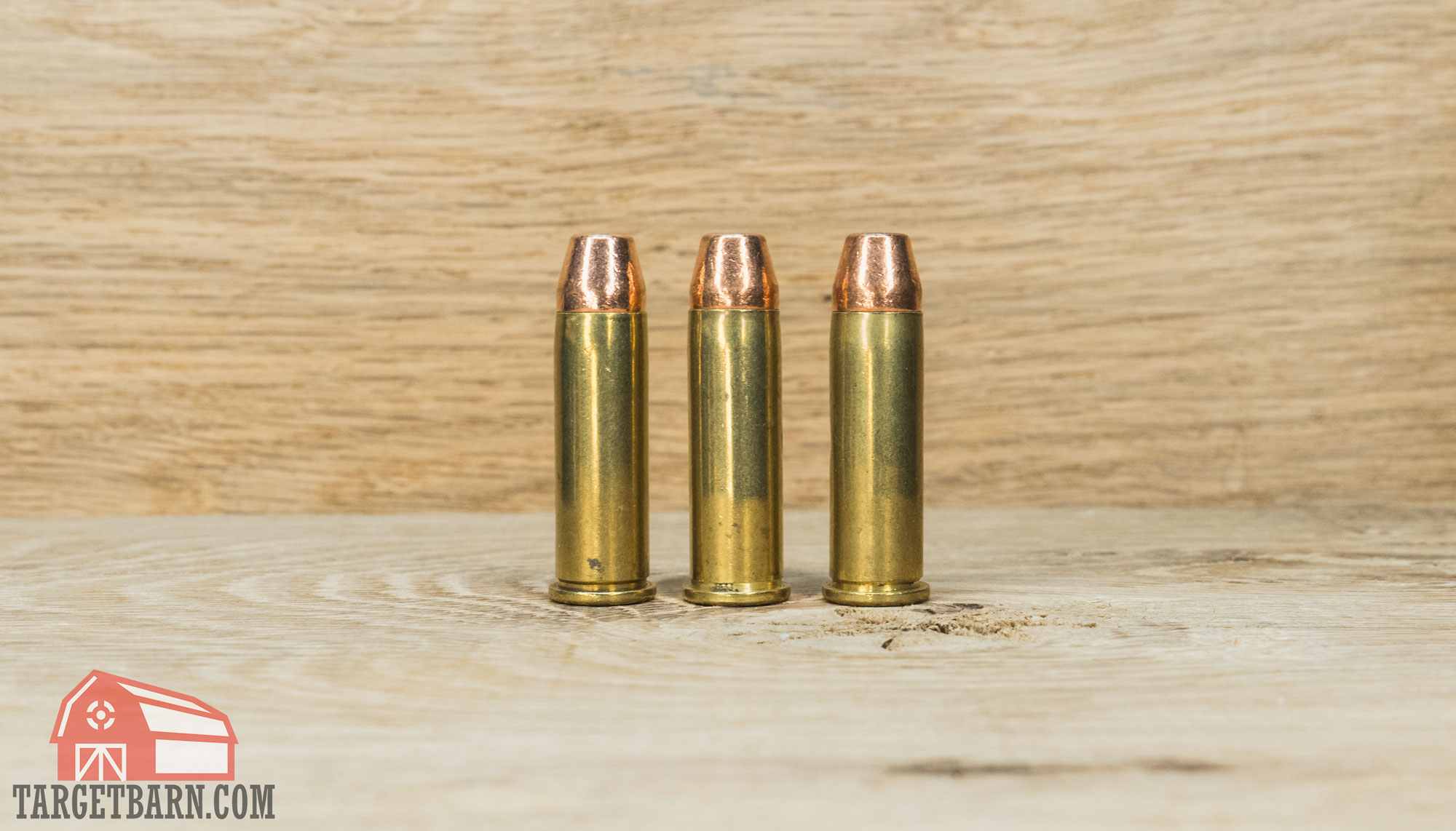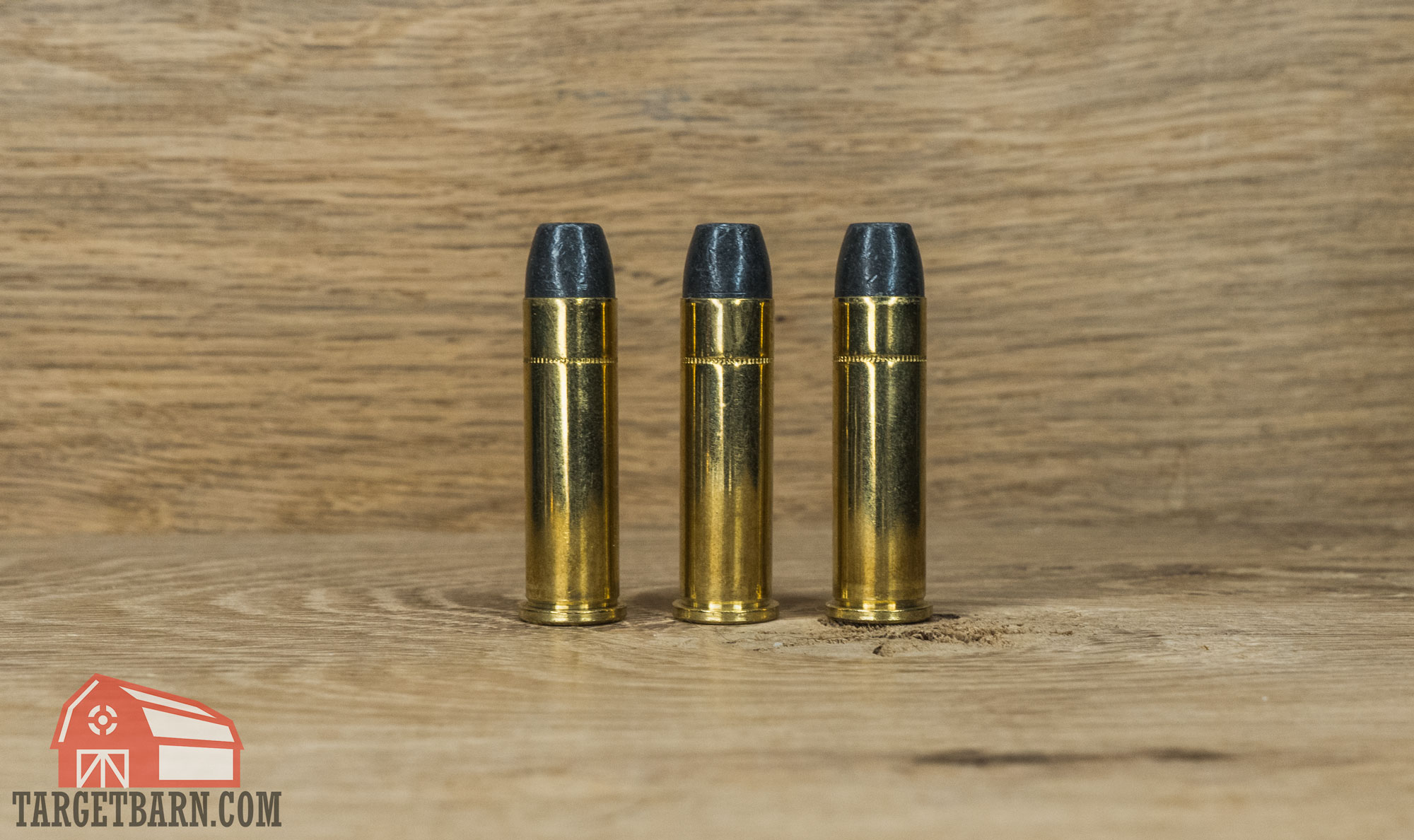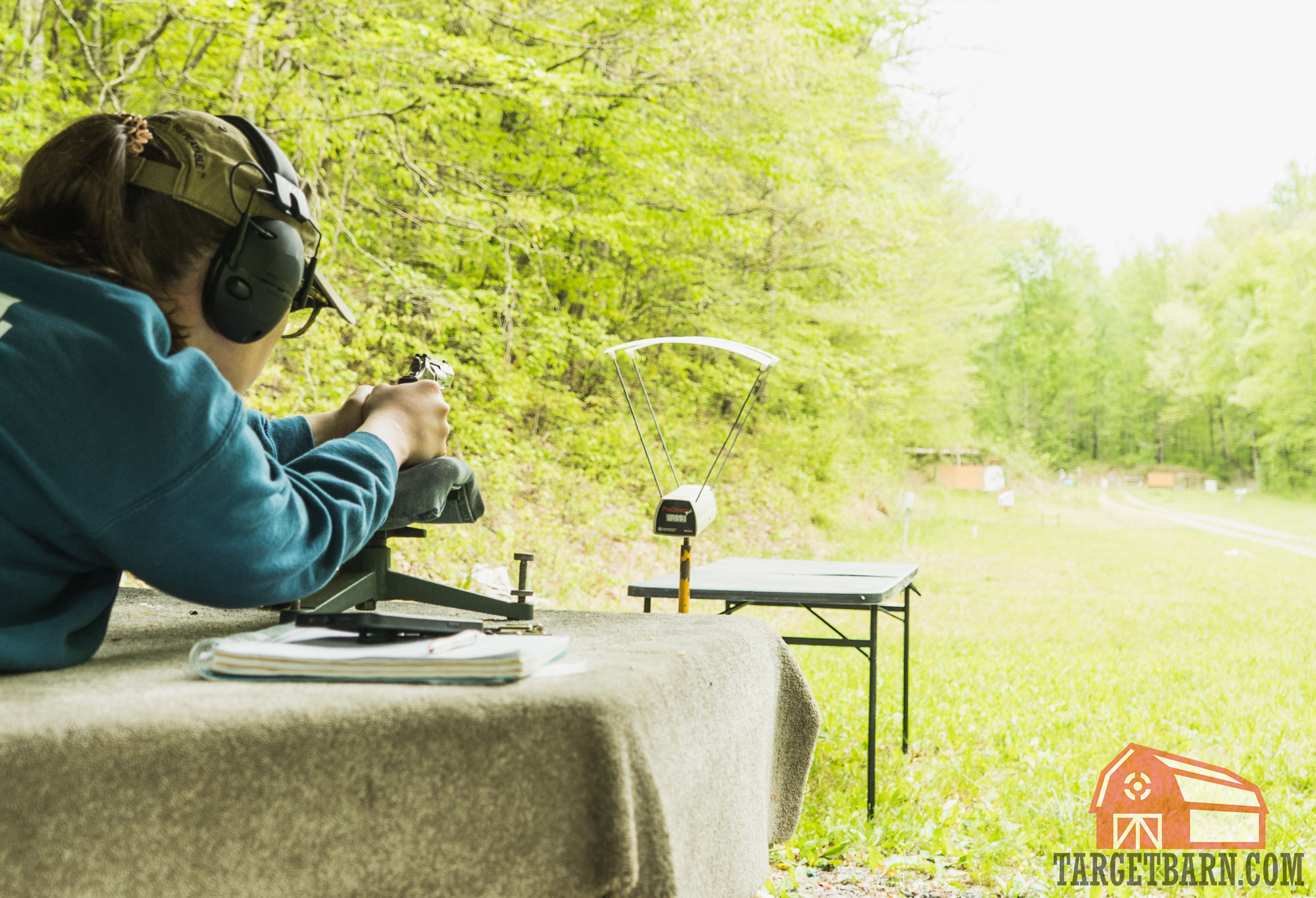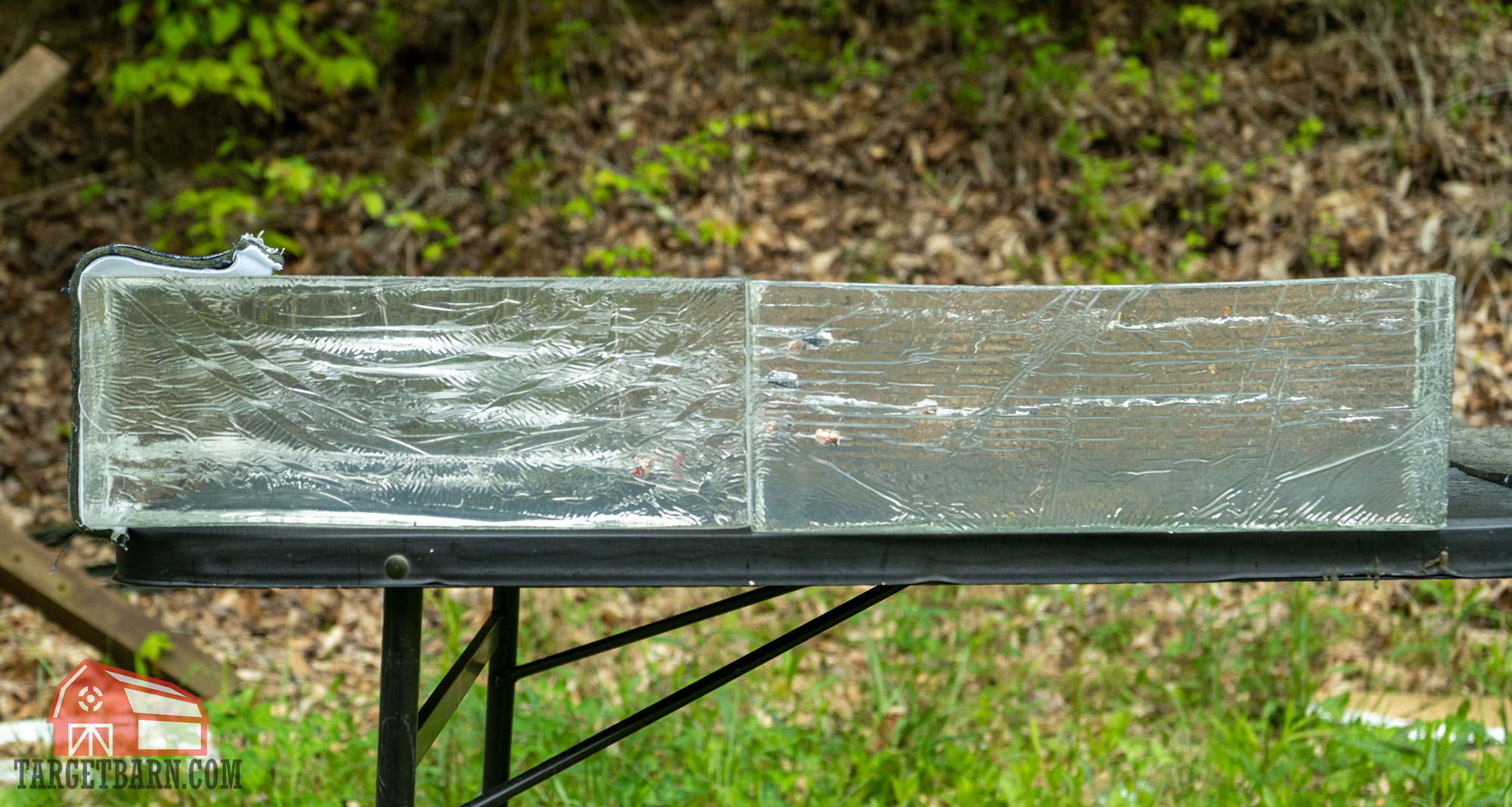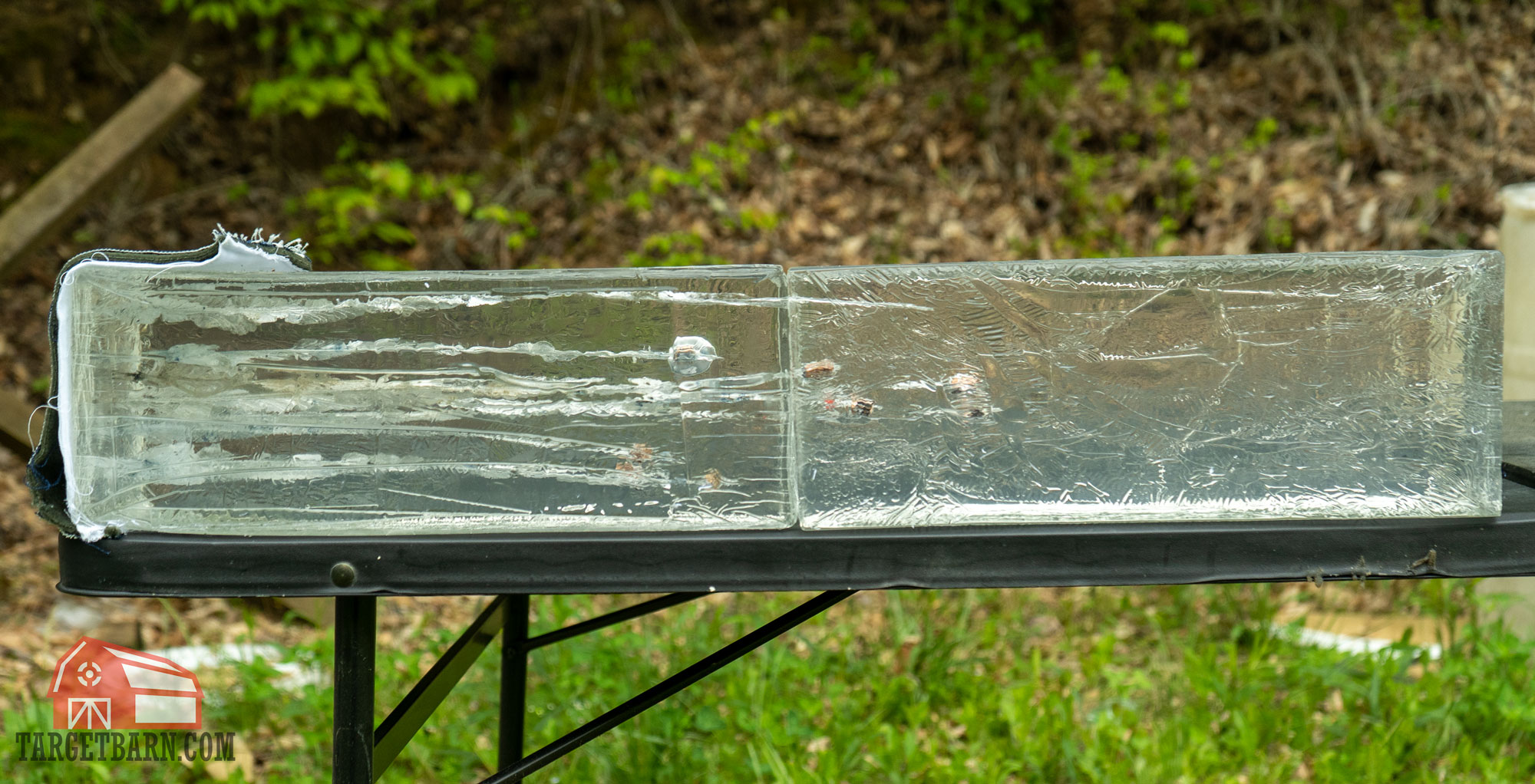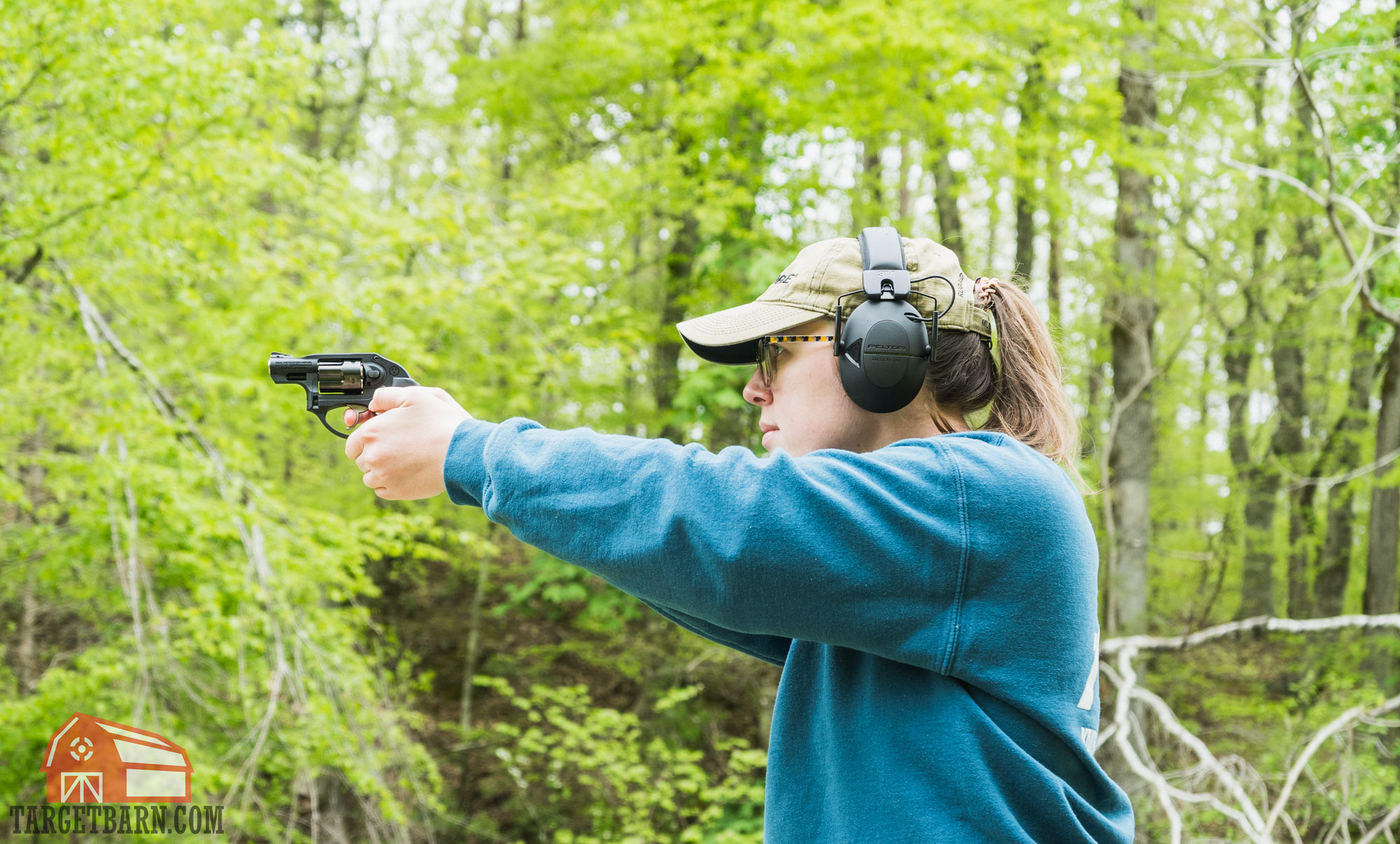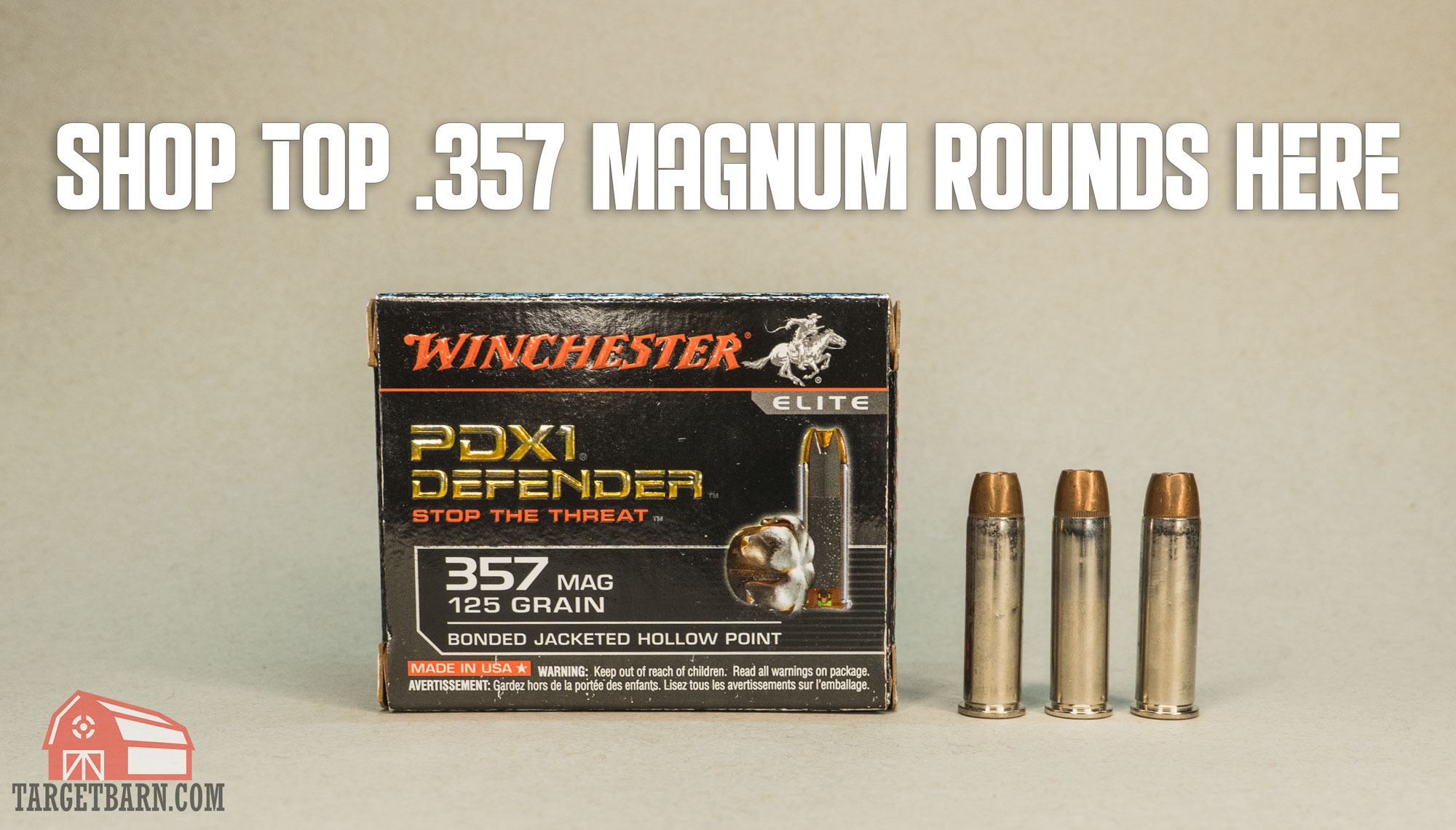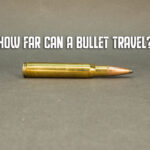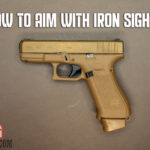When talking about revolvers, shooters often compare the .38 Special vs. .357 Magnum cartridges. Both are centerfire, rimmed revolver rounds using a .357″ diameter bullet. Some revolvers can even shoot both rounds. But while they share a number of similarities, there are also some important differences between the two rounds.
Keep reading to see our comparison of the .38 Special vs. .357 Magnum.
.38 Special vs. .357 Magnum Specifications
The basics of .38 Special vs. .357 Magnum:
- Both cartridges are revolver rounds
- Revolvers chambered for .357 Magnum can shoot both .38 Special and .357 Magnum cartridges; revolvers chambered for .38 Special can not shoot .357 Magnum cartridges
- Both rounds fire a .357″ diameter bullet
- The .357 Magnum is more powerful than the .38 Special
- A .357 Magnum will have much more recoil than a .38 Special
- .38 Special ammo is typically cheaper
| .38 Special | .357 Magnum | |
|---|---|---|
| Designed | 1898 | 1934 |
| Designer | Smith & Wesson | Elmer Keith, Phillip B. Sharpe, Douglas B. Wesson |
| Place of Origin | United States | United States |
| Parent Cartridge | .38 Long Colt | .38 Special |
| Case Type | Rimmed, straight | Rimmed, straight |
| Bullet Diameter | .357" | .357" |
| Rim Diameter | .44" | .44" |
| Case Length | 1.155" | 1.29" |
| Overall Length | 1.550" | 1.59" |
| Common Bullet Weights | 100 to 147 grains | 110 to 158 grains |
| Maximum Pressure (SAAMI) | 17,500 psi | 35,000 psi |
As we said above, both the .38 Special and .357 Magnum rounds are rimmed revolver rounds that use a .357″ diameter bullet. The .357 Magnum is slightly taller and packs a lot more punch than the .38 Special.
.38 Special vs. .357 Magnum History
Next, let’s take a look at the history behind each round.
.38 Special History
The .38 Special is derived from the .38 Long Colt round. Due to the .38 Long Colt’s poor performance in the Philippines during the Spanish-American War, the US government enlisted Smith & Wesson’s help in designing a new revolver cartridge. Smith & Wesson’s answer was the .38 Special. The cartridge’s bullet was the same diameter as the .38 Long Colt, but with a heavier bullet and hotter black powder charge. Smith & Wesson soon offered the round in a smokeless powder loadings due to its popularity.
Throughout the 1920s through 1980s, the .38 Special was the chosen service revolver caliber among American law enforcement. It also saw use in World War I, World War II, the Korean War, and Vietnam War.
.357 Magnum History
In the 1930s, there was a need for a revolver round that offered better penetration than the .32- and .38-caliber revolvers in use by law enforcement. Smith & Wesson’s light-framed Military & Police revolvers could not handle much hotter loads, so the company took its heavy .44 frame and chambered it in .38 Special. This new 5-inch revolver, called the .38/44 Heavy Duty, could handle much hotter .38 loads.
However, gun writers Philip Sharpe and Elmer Keith both felt that the load could have better performance, specifically in terms of higher velocities. Smith & Wesson’s then Vice President Douglass B. Wesson teamed up with Sharpe to develop the new load which was completed in 1934. The new .357 Magnum was .125” longer than the .38 Special, and had a 158-grain bullet that traveled at 1,515 fps out of an 8 ¾” barrel.
Over the years, the .357 Magnum cartridge has been a popular high-velocity round for hunting, law enforcement, and self-defense.
Can you shoot .38 Special out of a .357 Magnum revolver?
You can shoot .38 Special ammo out of .357 Magnum revolvers. In fact, you can also safely shoot .38 Long Colt and .38 Short Colt out of a .357 Magnum revolver. However, the opposite is not true. You can not shoot .357 Magnum ammo out of a revolver designated for .38 Special. The designers of the cartridge actually lengthened it by approximately ⅛” to prevent it from fitting in a revolver cylinder designed for .38 Special only.
Is .357 Magnum more powerful than .38 Special?
The .357 Magnum cartridge can be twice as powerful as the .38 Special. Revolvers chambered in .357 Magnum are designed to handle a maximum pressure up to 35,000 psi according to SAAMI standards. Revolvers chambered in .38 Special have a maximum pressure of 17,500 psi by SAAMI standards. This means that .357 Magnum revolvers are built to withstand pressures double that of the .38 Special.
.38 Special vs. .357 Magnum Recoil
When debating between .38 Special vs. .357 Magnum for self defense, recoil must be considered.
While felt recoil is influenced by a number of different factors, even the most experienced shooters will tell you that the .357 Magnum has more kick and muzzle flash than the .38 Special. This heavy recoil will often cause flinching, which can have a negative effect on follow up shots.
.38 Special vs. .357 Magnum Ballistics
Now let’s look at how the .38 Special and .357 Magnum stack up ballistically.
We decided to check velocities of a few different loads of each caliber, as well as shoot two rounds of each in ballistic gelatin. To measure muzzle velocity, we shot five rounds of each loading through a chronograph to get an average velocity.
To see how each round might perform in a self defense-scenario, we shot two rounds of each loading through Clear Ballistic’s 10% synthetic ballistic gel with a 4-layer fabric covering as barrier from a 10-foot distance. We then measured penetration depth and bullet expansion for each round. The .38 Special rounds were fired from a revolver with a 1.87″ barrel and the .357 Magnum rounds were fired from a revolver with a 2.25″ barrel.
The FBI’s standards for ballistic testing call for penetration between 12 and 18 inches. This correlates with rounds that will adequately penetrate soft tissue. When looking at expansion, experts generally look for an expanded diameter of 1.5 times the original diameter of the bullet. That’s because you want your defensive round to create a wide wound channel, which occurs when the bullet expands as it travels through the target.
Before we jump into the results, keep in mind that these brief tests are used to give an idea of how these rounds might perform and should not be the sole factor in selecting a round for self defense.
.38 Special Ballistics
| Cartridge | Average Velcoity (fps) | Average Penetration (inches) | Average Bullet Expansion (inches) | Average Muzzle Energy (ft/lbs) |
|---|---|---|---|---|
| Hornady 125gr XTP | 842 | 19.59" | 0.351" | 197.09 |
| Federal 158gr. HP SWCHP | 770 | 17.63" | .352" | 208.34 |
| Hornady Critical Defense 110gr. +P FTX | 962 | 14" | 0.453" | 226.4 |
| Hornady Custom 158gr. XTP | 674 | 17.69" | .371" | 159.63 |
Unsurprisingly, all of the .38 Special rounds tested clocked in under 1,000 fps muzzle velocities. In the ballistic gel, all reached the minimum penetration of 12 inches, but one round over penetrated. As for expansion, we’re looking for about .54″ expansion, which none of the rounds adequately reached.
Often, the issue with .38 Special ammo out of short-barrel revolvers is that they don’t gain enough velocity to expand upon impact. This usually leads to over-penetration. While we didn’t see too much over-penetration in this data set, we did see a lack of expansion.
.357 Magnum Ballistics
| Round | Average Velcoity (fps) | Average Penetration (inches) | Average Bullet Expansion (inches) | Average Muzzle Energy (ft/lbs) |
|---|---|---|---|---|
| Critical Defense 135gr. FlexLock | 1200 | 19.75" | .445" | 432.35 |
| Federal 125gr. JHP | 1235 | 14.5" | .494" | 424.01 |
| Remington 180gr. SJHP | 1061 | 19.19" | .401" | 450.65 |
| Speer Gold Dot 135gr. GDHP | 1082 | 12.94" | .535" | 351.5 |
The .357 Magnum cartridge is known for its stopping power. So, as expected, it performed well in our gel test, showing high velocities and having no trouble penetrating to desired depths. While none of the rounds tested expanded to the .54″ that we were looking for, as a whole, the .357 Magnum expanded better than the .38 Special.
.38 Special vs. .357 Magnum Ammo Price
When shopping for .38 Special and .357 Magnum ammo, you’ll find that, generally, .38 Special is cheaper per round than .357 Magnum.
Of course, you can find some .38 Special ammo that is more expensive than .357 Magnum. For example, a .38 Special round using a jacketed hollow point bullet, like the Federal Premium .38 Special +P 129gr. Hydra-Shok JHP will be over double the cost per round as the Fiocchi .357 Magnum 142gr. FMJ round.
.38 Special vs. .357 Magnum: Which should you choose?
Both the .38 Special and .357 Magnum offer adequate ballistics for self defense. Many shooters lean towards the .357 Magnum for its strong ballistic performance, however, you should determine if that extra power is worth the added recoil and muzzle blast.
Dr. Gary Roberts, a leading researcher in ballistics, gives some good insight:
“There is no reason to go with .357 Mag in a J-frame, as the significantly larger muzzle blast and flash, and harsher recoil of the .357 Magnum does not result in substantially improved terminal performance compared to the more controllable .38 Special bullets when fired from 2” barrels.”

